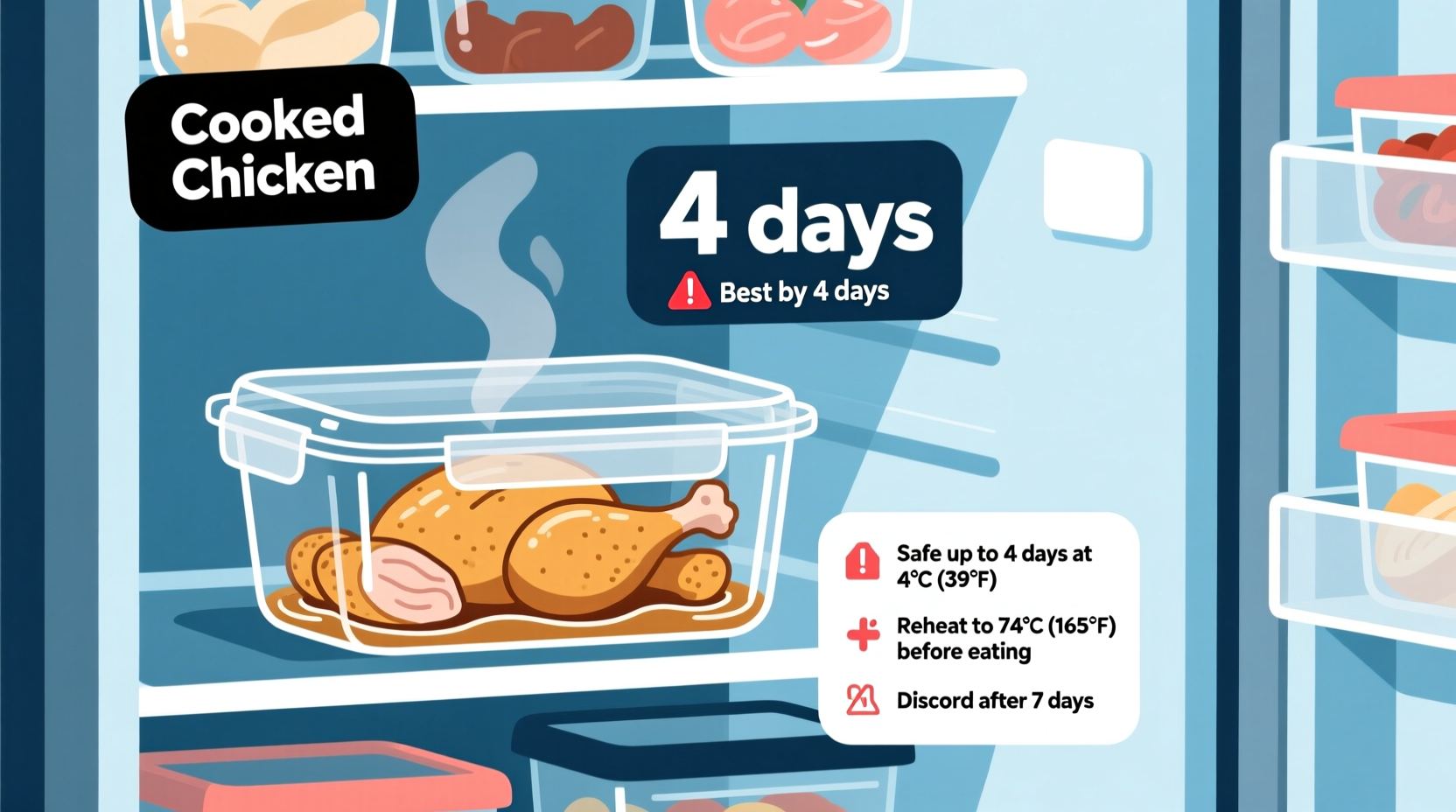Cooked chicken remains safe to eat for 3-4 days when stored properly in the refrigerator at or below 40°F (4°C). This timeframe comes directly from USDA Food Safety and Inspection Service guidelines to prevent foodborne illness from bacteria like Salmonella and Campylobacter.
Ever pulled that container of roasted chicken from your fridge and wondered, "Is this still safe to eat?" You're not alone. Millions of home cooks face this uncertainty daily, potentially risking food poisoning by guessing at safe storage times. Let's cut through the confusion with science-backed guidelines you can trust.
Why the 3-4 Day Rule Exists for Cooked Chicken
The USDA's Food Safety and Inspection Service establishes the 3-4 day refrigeration limit for cooked poultry based on bacterial growth rates in the "danger zone" (40°F-140°F). Even properly cooked chicken becomes vulnerable to pathogens once it cools. USDA research shows that harmful bacteria like Staphylococcus aureus can double in number every 20 minutes within this temperature range.
"Many people don't realize that cooking kills bacteria but doesn't eliminate heat-stable toxins that some pathogens produce," explains food safety researcher Dr. Elizabeth Chen. "That's why strict adherence to storage timelines is non-negotiable for cooked poultry."
Maximizing Freshness: Your Step-by-Step Storage Protocol
Following these steps immediately after cooking dramatically impacts how long your chicken remains safe:
- Cool rapidly: Divide large portions into shallow containers (no deeper than 2 inches) to cool from 140°F to 70°F within 2 hours
- Seal properly: Use airtight containers or vacuum-sealed bags—never leave chicken uncovered
- Temperature check: Verify your refrigerator maintains 40°F or below with an independent thermometer
- Strategic placement: Store on middle shelves away from the door where temperatures fluctuate most

Spoilage Detection: Beyond the Clock
While the 3-4 day rule provides a safety net, always perform these checks before consuming:
- Visual inspection: Look for grayish-green discoloration or slimy film on the surface
- Smell test: Trust your nose—sour, ammonia-like, or sulfur odors indicate spoilage
- Texture check: Properly stored chicken should remain firm, not sticky or slippery
Remember: Pathogenic bacteria often don't produce noticeable changes in food. If your chicken exceeds the 4-day limit, discard it regardless of appearance. The CDC reports that Salmonella causes approximately 1.35 million illnesses annually in the United States—many from improperly stored leftovers.
Special Storage Scenarios: When Timelines Change
Certain conditions alter the standard 3-4 day guideline. This comparison shows how different storage methods affect cooked chicken safety:
| Storage Method | Maximum Safe Duration | Critical Considerations |
|---|---|---|
| Standard refrigerator (40°F or below) | 3-4 days | Store in airtight containers away from dairy products |
| Chicken in broth or gravy | 2-3 days | Liquid environments accelerate bacterial growth |
| Freezer (0°F or below) | 4 months | Vacuum sealing extends quality; label with date |
| Room temperature (above 90°F) | 1 hour | Double danger zone risk; discard immediately |
When Freezing Makes Sense
If you won't consume chicken within 4 days, freezing preserves safety indefinitely (though quality degrades over time). Follow these best practices:
- Flash-freeze portions on a baking sheet before transferring to freezer bags
- Remove as much air as possible from storage containers
- Label with contents and date using freezer-safe markers
- Thaw overnight in the refrigerator—not at room temperature
The FDA's Food Code 2022 emphasizes that proper freezing halts bacterial growth completely, making it the only reliable method to extend cooked chicken's shelf life beyond refrigeration limits.
Reheating Safety: The Final Step
Even properly stored chicken requires careful reheating:
- Heat to 165°F internal temperature (use a food thermometer)
- Stir frequently when reheating in microwave for even heating
- Consume immediately after reheating—don't re-refrigerate
- Avoid multiple reheating cycles which degrade protein structure
"The critical temperature for killing pathogens is 165°F," notes Antonio Rodriguez, culinary safety expert. "But many home cooks rely on visual cues rather than thermometers, leaving them vulnerable to undercooked leftovers."
When to Toss: Clear Indicators of Unsafe Chicken
Discard cooked chicken immediately if you observe any of these signs:
- Mold growth in any color (white, green, black)
- Strong sour or rotten egg odor
- Visible slime or slippery texture
- Storage exceeding 4 days regardless of appearance
- Temperature abuse (left in car or unrefrigerated for >2 hours)
When in doubt, throw it out. The USDA's FoodSafety.gov states that foodborne illness costs Americans over $15.5 billion annually in healthcare and lost productivity—far exceeding the value of any questionable leftovers.











 浙公网安备
33010002000092号
浙公网安备
33010002000092号 浙B2-20120091-4
浙B2-20120091-4